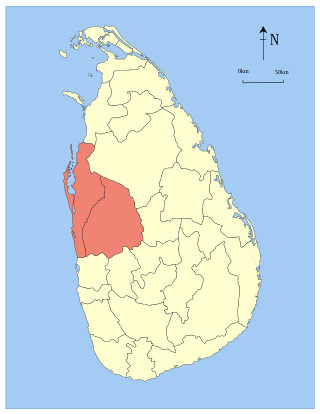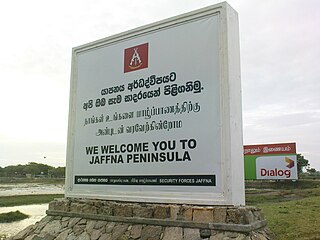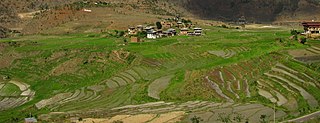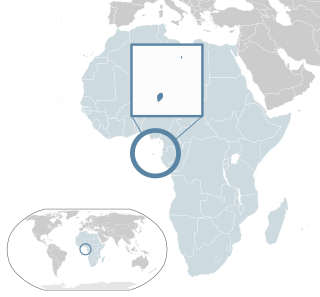
Cardamom, sometimes cardamon or cardamum, is a spice made from the seeds of several plants in the genera Elettaria and Amomum in the family Zingiberaceae. Both genera are native to the Indian subcontinent and Indonesia. They are recognized by their small seed pods: triangular in cross-section and spindle-shaped, with a thin, papery outer shell and small, black seeds; Elettaria pods are light green and smaller, while Amomum pods are larger and dark brown.

A cash crop, also called profit crop, is an agricultural crop which is grown to sell for profit. It is typically purchased by parties separate from a farm. The term is used to differentiate marketed crops from staple crop in subsistence agriculture, which are those fed to the producer's own livestock or grown as food for the producer's family.

Sri Lankan cuisine is known for its particular combinations of herbs, spices, fish, vegetables, rices, and fruits. The cuisine is highly centered around many varieties of rice, as well as coconut which is a ubiquitous plant throughout the country. Seafood also plays a significant role in the cuisine, be it fresh fish or preserved fish. As a country that was a hub in the historic oceanic silk road, contact with foreign traders brought new food items and cultural influences in addition to the local traditions of the country's ethnic groups, all of which have helped shape Sri Lankan cuisine. Influences from Indian, Indonesian and Dutch cuisines are most evident with Sri Lankan cuisine sharing close ties to other neighbouring South and Southeast Asian cuisines.

Kegalle is a large town in Sabaragamuwa Province of Sri Lanka. It is located on the Colombo–Kandy road, approximately 78 km (48 mi) from Colombo, 40 km (25 mi) from Kandy, 32 km (20 mi) from Kurunegala and 46 km (29 mi) from Avissavella. It is the main town in the Kegalle District, which is one of two districts which comprise Sabaragamuwa Province. The town is governed by an Urban Council.

North Western Province is a province of Sri Lanka. The province consists of the districts of Kurunegala and Puttalam. Its capital is Kurunegala, which has a population of 28,571. The province is known mainly for its numerous coconut plantations. Puttalam, Kuliyapitiya, and Chilaw are the other major cities in the North Western Province. The majority of the population of Wayamba province is of Sinhalese ethnicity. There is also a substantial Sri Lankan Moor minority around Puttalam and Sri Lankan Tamils in Udappu and Munneswaram. Fishing, prawn farming and rubber tree plantations are other prominent industries of the region. The province has an area of 7,888 km2, and a population of 2,370,075.

The Jaffna Peninsula is a region in the Northern Province of Sri Lanka. It is home to the capital city of the province, Jaffna, and comprises much of the former land mass of the medieval Jaffna Kingdom.

Malagasy cuisine encompasses the many diverse culinary traditions of the Indian Ocean island of Madagascar. Foods eaten in Madagascar reflect the influence of Southeast Asian, African, Oceanian, Indian, Chinese and European migrants that have settled on the island since it was first populated by seafarers from Borneo between 100 CE and 500 CE. Rice, the cornerstone of the Malagasy diet, was cultivated alongside tubers and other Southeast Asian and Oceanian staples by these earliest settlers. Their diet was supplemented by foraging and hunting wild game, which contributed to the extinction of the island's bird and mammal megafauna. These food sources were later complemented by beef in the form of zebu introduced into Madagascar by East African migrants arriving around 1,000 CE.

Agriculture in Colombia refers to all agricultural activities, essential to food, feed, and fiber production, including all techniques for raising and processing livestock within the Republic of Colombia. Plant cultivation and livestock production have continuously abandoned subsistence agricultural practices in favour of technological farming resulting in cash crops which contribute to the economy of Colombia. The Colombian agricultural production has significant gaps in domestic and/or international human and animal sustenance needs.

Agriculture is the largest employment sector in Bangladesh, making up 14.2 percent of Bangladesh's GDP in 2017 and employing about 42.7 percent of the workforce. The performance of this sector has an overwhelming impact on major macroeconomic objectives like employment generation, poverty alleviation, human resources development, food security, and other economic and social forces. A plurality of Bangladeshis earn their living from agriculture. Due to a number of factors, Bangladesh's labour-intensive agriculture has achieved steady increases in food grain production despite the often unfavorable weather conditions. These include better flood control and irrigation, a generally more efficient use of fertilisers, as well as the establishment of better distribution and rural credit networks.

Agriculture in Indonesia is one of the key sectors within the Indonesian economy. In the last 50 years, the sector's share in national gross domestic product has decreased considerably, due to the rise of industrialisation and service sector. Nevertheless, for the majority of Indonesian households, farming and plantation remains as a vital income generator. In 2013, the agricultural sector contributed 14.43% to national GDP, a slight decline from 2003's contribution which was 15.19%. In 2012, the agricultural sector provides jobs to approximately 49 million Indonesians, representing 41% of the country's total labor force.

Agriculture is one of the main industries in Taiwan. It contributes to the food security, rural development and conservation of Taiwan. Around 24% of Taiwan's land is used for farming.

Agriculture in Bhutan has a dominant role in the Bhutan's economy. In 2000, agriculture accounted for 35.9% of GDP of the nation. The share of the agricultural sector in GDP declined from approximately 55% in 1985 to 33% in 2003. Despite this, agriculture remains the primary source of livelihood for the majority of the population. Pastoralism and farming are naturally complementary modes of subsistence in Bhutan.

Agriculture employs the majority of Madagascar's population. Mainly involving smallholders, agriculture has seen different levels of state organisation, shifting from state control to a liberalized sector.

Agriculture in Sierra Leone is a significant part of the economy of Sierra Leone, with it accounting for 58 percent national Gross Domestic Product (GDP) in 2007. Two-thirds of the population of Sierra Leone are involved in subsistence agriculture.

Santomean cuisine comprises the cuisine, dishes and foods of São Tomé and Príncipe, a Portuguese-speaking island nation in the Gulf of Guinea, off the western equatorial coast of Central Africa. The country consists of two archipelagos around the two main islands: São Tomé and Príncipe, located about 140 kilometres (87 mi) apart and about 250 and 225 kilometres, respectively, off the northwestern coast of Gabon.

Coffee production in Sri Lanka peaked in 1870, with over 111,400 hectares being cultivated. The Dutch had experimented with coffee cultivation in the 18th century, but it was not successful until the British began large scale commercial production following the Colebrooke–Cameron Commission reforms of 1833. By 1860, the country was amongst the major coffee-producing nations in the world. Although coffee production remains a source of revenue, it is no longer a main economic sector. In 2014, the country ranked 43rd of largest coffee producers in the world.
Sugarcane is the only crop cultivated in Sri Lanka for manufacture of sugar. This crop can be growth on well drained soil up to an elevation of about 1,000 m (3,300 ft). Sugarcane has been cultivated in Sri Lanka since 19th century. About three decades ago, in the 1970s Sri Lanka was cultivated in about 25,000 ha. There were 3,840 ha in Kantale, 5,660 ha in Hingurana, 4,500 ha in Pelwatte, 4,680 ha in Seveanagala and 5,700 ha in Moneragala. At present, only Pelwatta and Sevanagala factories are functioning. Cultivation at Hingurana has started and it is likely that the factory will start production in 2010. Most of the lands cultivated with sugarcane are in the intermediate zone. Receiving annual rainfall of 1,250–2,000 mm (49–79 in) distributed in a bimodal pattern.

Agriculture is the main part of Tanzania's economy. As of 2016, Tanzania had over 44 million hectares of arable land with only 33 percent of this amount in cultivation. Almost 70 percent of the rich population live in rural areas, and almost all of them are involved in the farming sector. Land is a vital asset in ensuring food security, and among the nine main food crops in Tanzania are maize, sorghum, millet, rice, wheat, beans, cassava, potatoes, and bananas. The agricultural industry makes a large contribution to the country's foreign exchange earnings, with more than US$1 billion in earnings from cash crop exports.
Cocoa production contributes to the national economy of Sri Lanka. It is grown in fairly dense shade and generally cultivated under coconut and rubber. Although cocoa production remains a source of revenue, it is no longer a main economic sector. The great part of cocoa cultivation occurs in the Matale, Kandy, Badulla, Kurunegala, Kegalle and Monaragala districts. The first cocoa plants were introduced to the country in 1819. Recent years cocoa production has increased by nearly $22.6 million (2015).
Nestlé Lanka is a Sri Lanka–based foods company located in Colombo, Sri Lanka. Nestlé Lanka is a subsidiary of Nestlé, a Switzerland based company. Nestlé's products include baby food, medical food, bottled water, breakfast cereals, coffee and tea. The company was founded by the Anglo-Swiss Condensed Milk Company in 1906 and incorporated under Nestlé Ceylon Company. Nestlé Lanka is Sri Lanka's largest food company by revenue, with Rs 36.355 billion in 2019. The whole company is controlled by the Nestlé Switzerland parent company. Nestlé S.A. owns over 90 per cent total shares. Nestlé Lanka PLC became the seventh most valuable brand in Sri Lanka worth approximately Rs 21 billion in 2017.



















